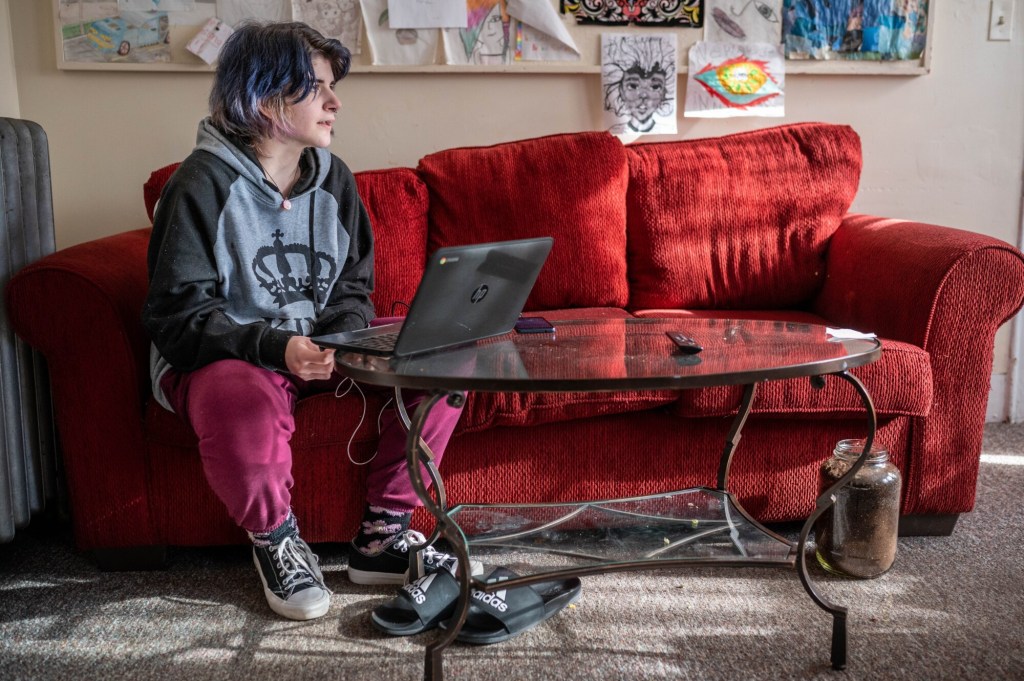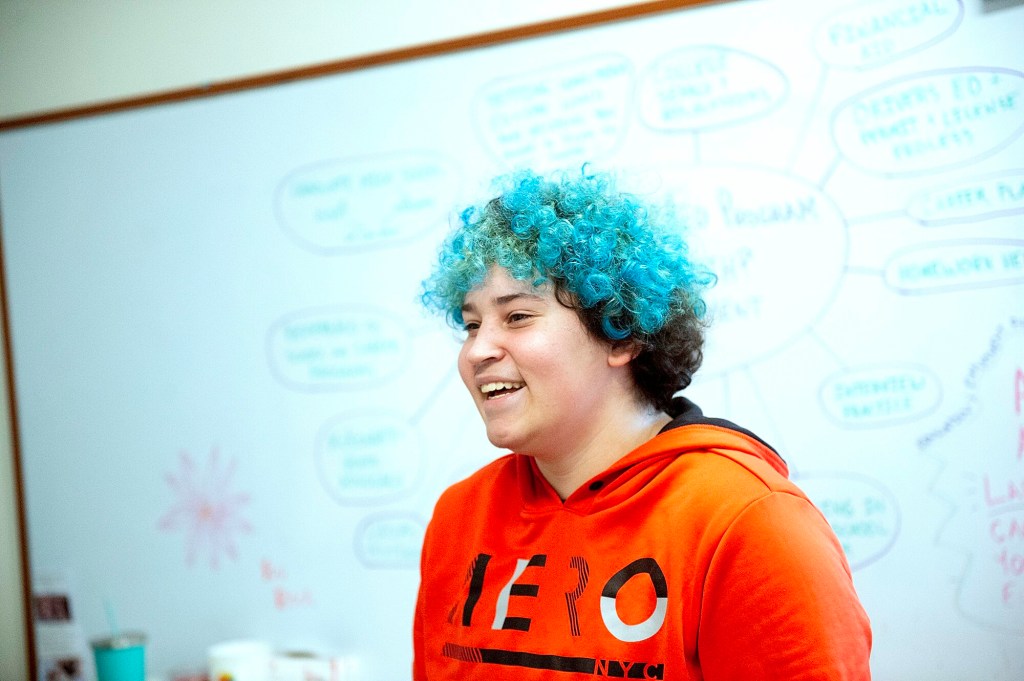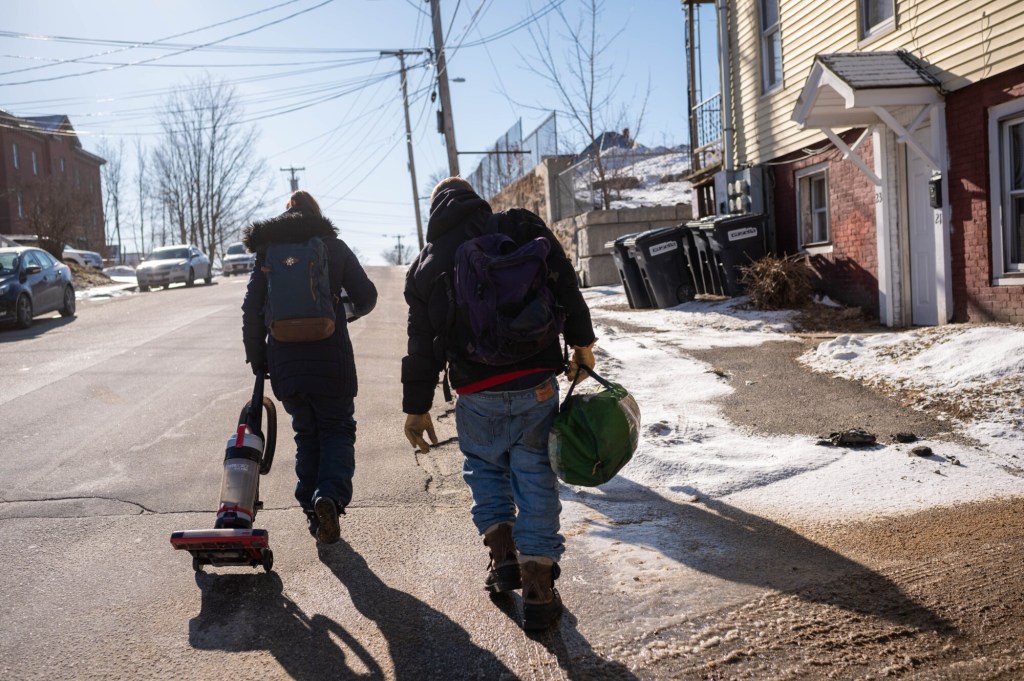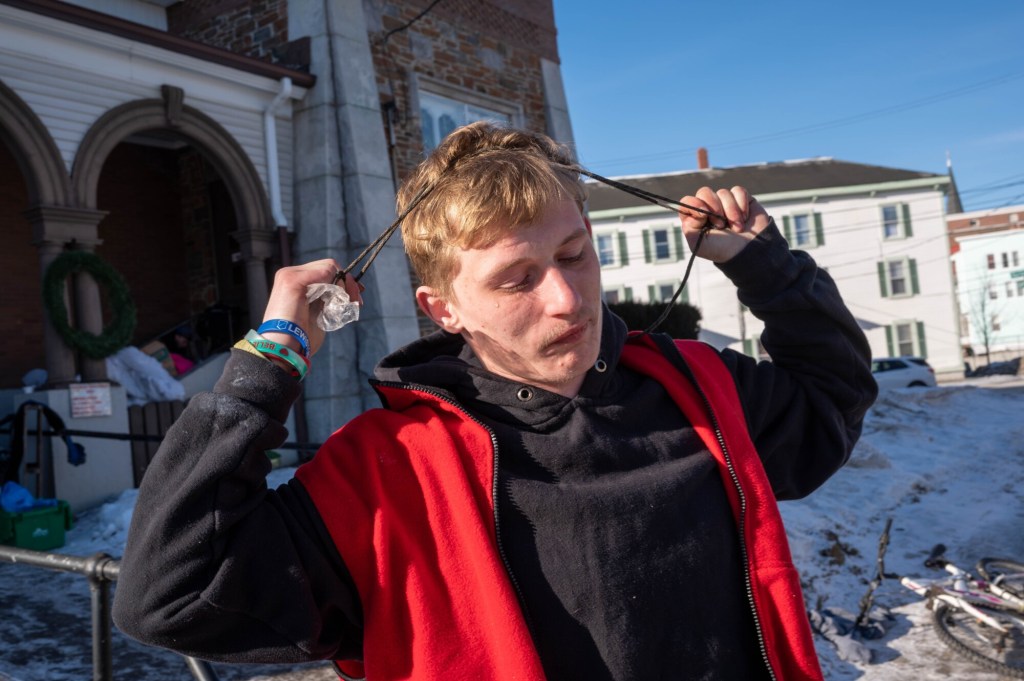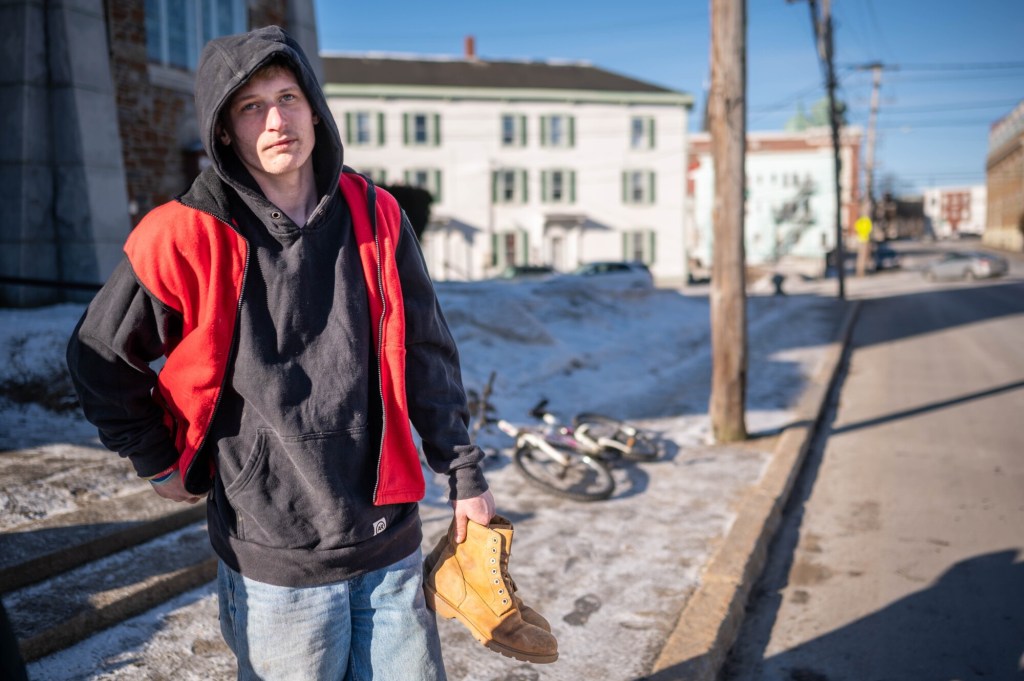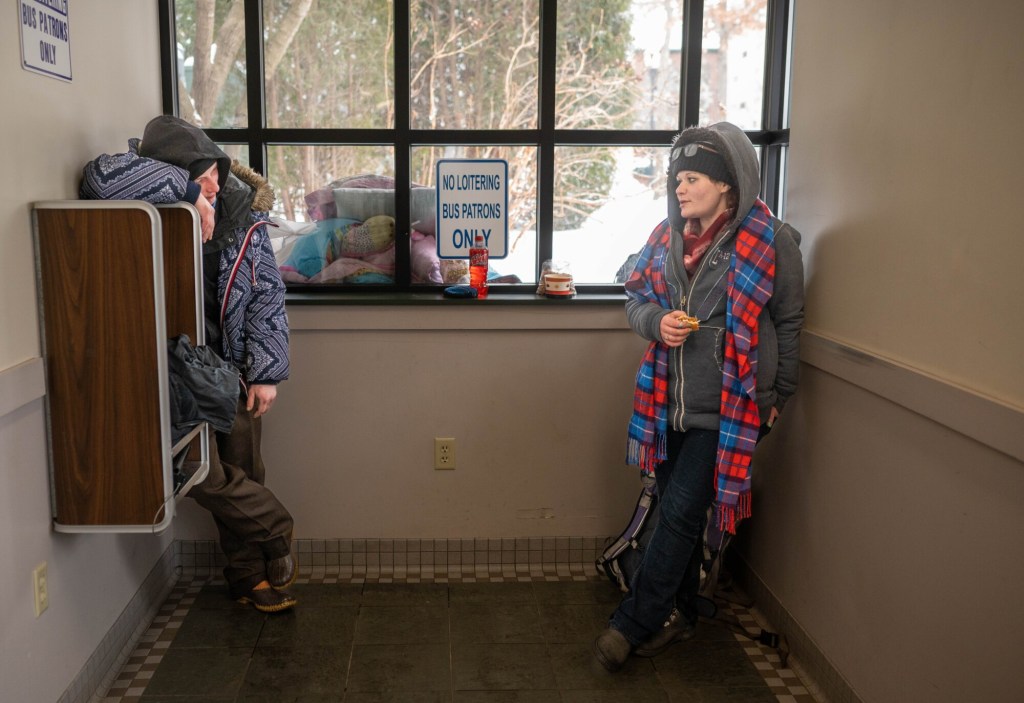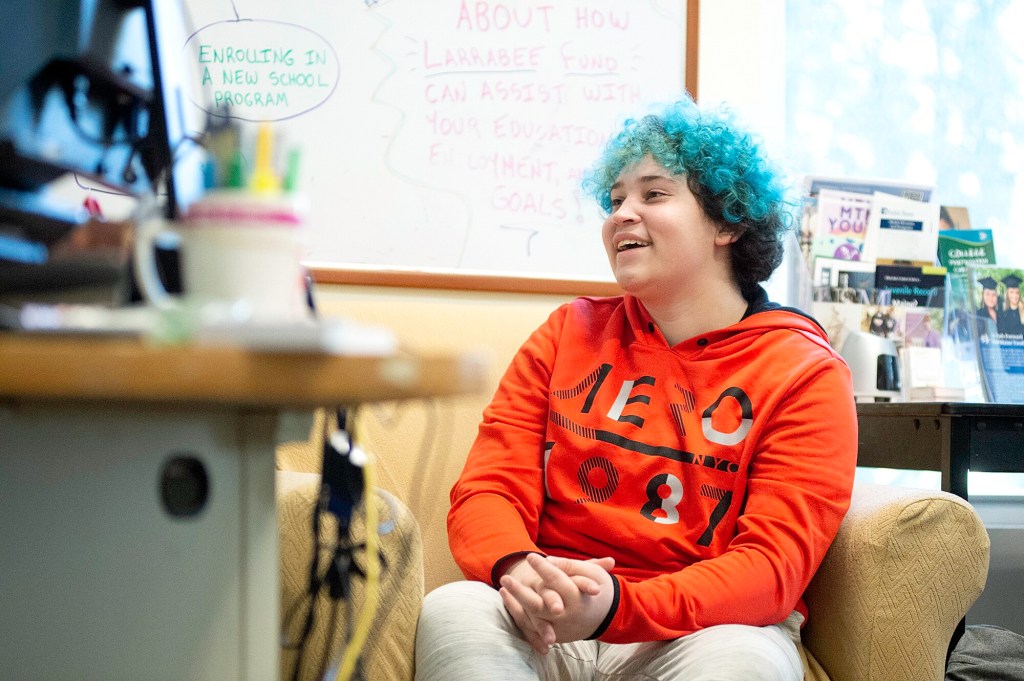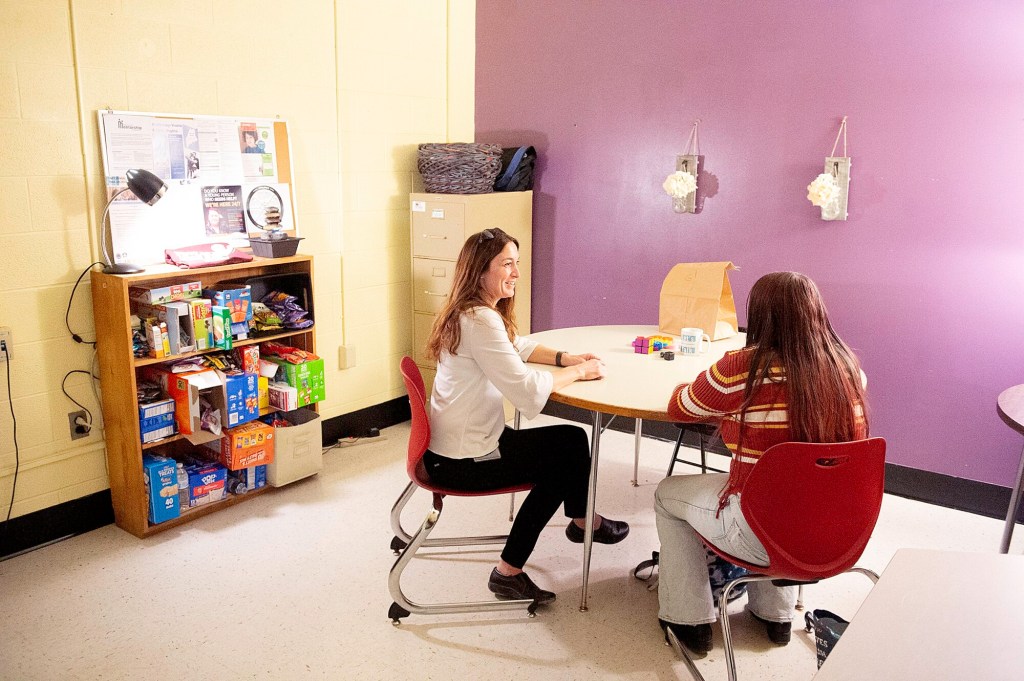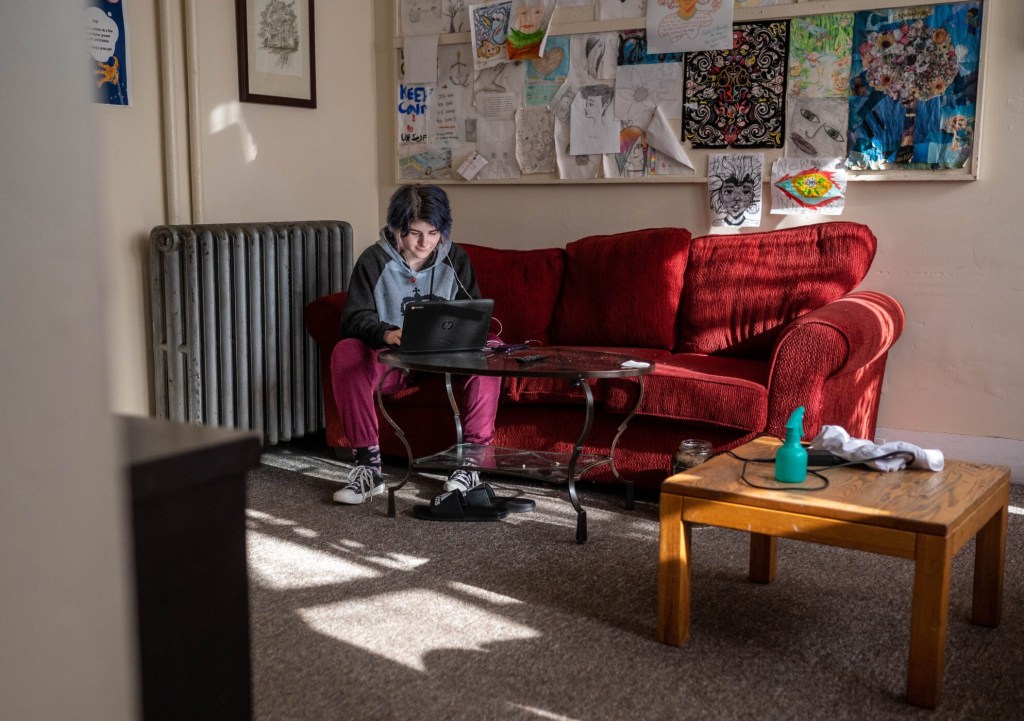Editor’s note: This is the third installment of an occasional series this winter examining homelessness in Maine.
Two weeks ago, Dylan Collins woke up outside, buried in snow.
It was suffocating, he said. His legs felt like they were paralyzed. When he was finally able to struggle out of his frozen sleeping bag, he found himself soaked from the waist down.

Earlier, as he waited for the warming center at the Calvary United Methodist Church to open at midnight, the 18-year-old had settled into his sleeping bag behind the bushes. Cold and tired, he decided to sleep.
Someone tried to rouse him when the church opened. But he was too cold to struggle, and his sleeping bag was frozen shut. He fell back asleep after the person left, only to wake up in a panic early the next morning.
“This homeless s*** sucks,” he said. “Nobody likes to help.”
Collins is among a growing number of teenagers and young adults across the state who are homeless. When it comes to the numbers, most youth are homeless together with their parents. A smaller, but more vulnerable segment are homeless minors and teenagers like Collins who are on their own — some too young to access most homeless shelters or qualify for government assistance programs.
Data from the National Center for Homeless Education indicates that about 17% of the more than 2,000 homeless youth in Maine are not in the physical custody of a parent or guardian. Tracking this population is especially challenging, in part because unaccompanied teenagers often do not want to bring attention to their situation due to shame or fear of state involvement.
The most accurate data available comes from public schools, which are required by law to offer special protections to homeless students. The most recent data from 2023 indicates Maine may be on track to identify the largest number of homeless youth — both accompanied and unaccompanied youth — in at least 10 years.
And without stable housing, experts say, the reality is youth are far more likely to drop out of school, get pregnant and become addicted to drugs. Research indicates that the longer youth live unhoused, the more difficult it is for them to disengage from street culture, finish their education and join the workforce.
What’s behind the rising numbers in unaccompanied homeless youth? Experts say the primary cause is unbearable family dysfunction.

Once homeless, Breezy Napier of Lewiston now serves on the Youth Action Board at New Beginnings in Lewiston. Daryn Slover/Sun Journal
WHEN HOME ISN’T SAFE
Breezy Napier was 15 when he ran away from his West Paris home for the last time.
Fighting with his stepfather was nothing new. But his words had become particularly cruel, Napier said, after he learned one of Napier’s best friends was transgender.
“When he was drinking, he’d go on rage fits,” he said. “He’d go back to that subject because he knew it hurt me so much.”
Napier, who was beginning to suspect he may be transgender himself, didn’t feel safe.
So, again and again, he ran away from home.
The last time Napier left home was an unseasonably warm November day. Wearing just a flannel shirt and ripped skinny jeans, he fled down a trail in the woods.
But as dark came and the temperature dropped, he didn’t know how to get home. Lost, with tears frozen to his face, he called 911 on his flip phone for help. Soon, rescuers found him and brought him to the hospital to be treated for hypothermia.
When his mother picked him up, she didn’t bring him home. She signed him into New Beginnings’ emergency youth shelter in Lewiston.
The majority of unaccompanied youth say they’ve experienced verbal, physical or sexual abuse at home, and many have parents with drug or alcohol addictions.
Despite living in such conditions, research suggests that in most cases, it’s parents themselves who ask their child to leave home. A survey from the Department of Health and Human Services also found that about half of unaccompanied youth had previously been in foster care.
“Kids don’t up and leave (home) for no reason,” said Amelia Lyons, the state coordinator for homeless education. “The vast, vast, vast majority of the time, there’s something else going on.”
Some homeless teenagers have no relationship with their parents at all. Others were left on their own after a parent died or moved out of Maine. Youth homeless advocate Jamie Caouette said she knows children as young as 12 who have been asked to find their own place to stay after they and their parents became homeless.
Conflict over a teenager’s gender or sexual identity often plays a significant role. According to the 2021 Maine Integrated Youth Health Survey, transgender teenagers were over four times more likely to indicate they had recently experienced some kind of housing instability.
“We see a lot of youth that come through our spaces that either have been told they can’t go home because of their identity or have expressed not feeling safe enough to return home for who they are,” said Signe Lynch, New Beginnings Education & Employment Support Program coordinator.
EqualityMaine Executive Director Gia Drew said there is far more awareness and education about lesbian, gay, bisexual, transgender and queer identities now than when she was a teenager 40 years ago. But broad systematic change and cultural acceptance haven’t come quick enough, Drew said, and many families still struggle to understand and appreciate the conflict their child is experiencing.
“I think we were on a good sort of path, (but) something’s really changed over the last four or five years. They’ve really made being young and LGBTQ even more dangerous for kids,” she said, highlighting hostile rhetoric from political officials as one example.
STRUGGLING TO NAVIGATE AN ADULT WORLD
After moving into New Beginnings’ emergency youth shelter, Napier cut his hair. Whereas before he had worn it long, he had the sides of his head shaved into a fade, leaving a tuft of hair on top.
“That was like the most awesome thing I ever did,” he said.
He began visiting New Beginnings’ drop-in center and made friends with other teenagers in similar situations. But life at the shelter wasn’t easy.
Rules were strict and Napier didn’t get along well with the staff. One of the shelter’s main goals is to help resolve conflict between homeless youth and their families, but he had little interest in returning home.
So he ran away from the shelter, too, numerous times, only to return either when he had nowhere else to go or found himself in a particularly bad situation. In the three years Napier was homeless, he spent many nights staying with friends, camping out on the streets and hanging outside New Beginnings’ outreach center in just a sleeping bag.
For years, Napier had been struggling with school. But after becoming homeless, he dropped out in the 10th grade when transportation from Oxford Hills Comprehensive High School ended.
Life as a homeless teen is difficult and demoralizing. Napier said he genuinely didn’t think he would live to turn 18.
Because he was emancipated at 16, after neither of his parents appeared at a court hearing, he was able to apply for food stamps and a housing assistance voucher two years early. For some months, the first thing he did after receiving his monthly food stamps was grab a blanket, buy some subs from Webb’s Market in Lewiston and have a picnic with friends on the top level of the Oak Street parking garage.
“We just had a great day,” he said. At the time, all but one member of his tight-knit friend group were homeless.
But last July, Napier’s picnics ended after one of his best friends died of an overdose from what may have been a fentanyl-laced blunt.
The sudden death hit his friend group hard.
“It really f***** a lot of us up,” he said. “We all stopped talking to each other for a while, and I stopped doing my picnics.”
Napier’s seen the looks some people give him and his friends. He’s felt their judgment. Most teenagers on the streets are just trying to get by, he said.
“We’re just doing anything and everything we can to make sure we don’t starve at the middle (of) the day, so we don’t get frostbite,” he said.
Some might be able to work things out with their families, he acknowledged. But for the majority, becoming homeless was not a choice.
“You just got to remember, we’re still kids,” he said. “We didn’t do nothing wrong. We didn’t ask to be homeless. This isn’t fun.”
SELLING DRUGS HIS ONLY OPTION?
Just four shelters in Maine are able to house unemancipated, unaccompanied youth, according to a list by Maine Housing: New Beginnings’ Marian’s Place in Lewiston, Preble Street’s Joe Kreisler Teen Shelter in Portland, Shaw House in Bangor and The Northern Lighthouse’s Safe Harbor Shelter in Presque Isle. Other shelters in the state serve adults only or require youth to be in the company of a parent.
Licensed shelters like New Beginnings must attempt to receive consent from parents or legal guardians for minors to stay at their shelter. In cases where this isn’t possible or could put the youth at risk, the state can give permission instead. Teenagers over 18 and emancipated minors can give their own consent.
“It’s a major barrier,” Lynch said. “That is the guideline that we absolutely need to follow to keep our licensing and funding.”
New Beginnings has many other services for youth under 18 that do not require parent/guardian notification, including visiting the Lewiston Youth Outreach Drop-In Center, street-based services, Larrabee fund scholarships, and educational and employment support.
Even when young adults are able to stay in adult shelters, they often choose not to due to the shelter’s rules or the environment.
Unaccompanied minors are especially vulnerable because they lack the same rights as adults. Many food pantries are accessible to teenagers in need, however government assistance programs like the Supplemental Nutrition Assistance Program and Housing Choice Vouchers require applicants to be either 18 years old or emancipated.
“We have a lot of young people that are under the age of 18 that aren’t emancipated that are fully living on their own right now,” Lynch said. “That can be really tricky because some of them have years to go till they could even be eligible for additional services.”
Work permits, which enable 14- and 15-year-olds to be hired, require a signature from a parent or guardian. But even older teenagers and young adults face significant barriers for finding employment.
Many have never received a driver’s license, which requires access to a car and an adult willing to supervise during the permit stage. Not only do most homeless youth lack transportation, but they often don’t have their birth certificate or Social Security card on hand either. Without the necessary identification to be hired, teenagers are left with few legal avenues to earn money.
“If we were able to get jobs and start buying our own food, some of these kids out here that I’ve seen selling drugs wouldn’t have to do that,” Napier said.
In spite of his aversion to drugs, Napier said even he considered selling. “I really sat with no money and just really thought about it for a while, like months,” he said. “Is that really my only option?”
SLIPPING THROUGH THE CRACKS
None of the underlying problems of youth homeless are new, Lynch said. But the pandemic has served to amplify existing crises, including poverty, drug use and housing shortages.
Unaccompanied youth are more vulnerable to labor and sex trafficking, assault and other forms of victimization than their peers. A survey by the U.S. Department of Health and Human Services found that more than 60% of homeless youth have been raped, beaten up, robbed or otherwise assaulted, and over a third have traded sex for money, food, protection, drugs or a place to spend the night.
Homelessness is also strongly associated with poor educational outcomes. According to data from the Maine Department of Education, just 59% of homeless high-schoolers in the Class of 2022 graduated last year, far below the state average of 86%. This data only includes students who were identified to be homeless as seniors.
“It is very easy to just not attend the school and have pretty minimal consequences from that,” Lynch said. “That can be really tricky.”
Without a high school diploma, youth face poor employment prospects and are far more likely to remain homeless as adults.
Professional support, including mental health and substance use counseling, is crucial for youth to rebuild their lives, experts say. Early intervention can be critical for keeping teenagers and young adults on the right track. But even with the right connections, achieving stability is not guaranteed. For some, it’s too little, too late.
“The systems are complicated, and without a case manager or someone that’s there to support you, it can be nearly impossible to navigate those systems,” Lynch said. “We just see this never-ending cycle of people that just keep slipping through the cracks.”
One of the biggest hurdles for unaccompanied homeless teenagers is a place to stay when they are no longer eligible for youth emergency housing.

Noah Nelson sits in the living room of New Beginnings’ Marian’s House in Lewiston. The house provides 24-hour emergency housing and support for youths ages 10 to 19 years old who have either run away, or are homeless or facing intense family conflict. Andree Kehn/Sun Journal
NO PLACE TO GO
Noah Nelson is one of a dozen teenagers currently staying at New Beginning’s emergency youth shelter. “It’s been quite stressful in all honesty, because after this shelter, I actually have nowhere to go,” the 18-year-old said recently.
New Beginnings’ license allows teenagers to stay at the shelter for up to 90 days. In some cases, the shelter is able to receive permission from the state to extend their stay. Nelson said he’ll reach 90 days with the shelter the second week in March.
While he’s been receiving help from New Beginnings case management staff, finding an apartment in the current housing market is near impossible. Nelson, who attends Franklin Alternative School in Auburn, doesn’t have any income. Even if he’s able to secure a housing assistance voucher, it’s unlikely that he would find a landlord willing to accept it.
Nelson said his friend’s family has offered to take him in again. But, he has a hard time accepting help.
“Growing up, I was taught that help was earned, and anytime my mother would help me, she would make me feel guilty about it,” he said. “So now I have this fear that asking for help is going to get me yelled at.”
Often, homeless teenagers like Nelson seek assistance from transitional living programs run by nonprofits like New Beginnings. These programs provide housing and support to help homeless youth develop independent living skills.
But the need for such programs is far greater than the placements available.
Chrissy Noble, a youth worker at New Beginnings’ shelter, said she has seen the number of transitional housing programs decrease in the last 14 years due to lack of funding. “That secondary housing, I guess for a lack of a better word, is where the need is,” she said. “We can get them in (to the emergency shelter), but there’s no place to go after that.”
Without access to long-term, stable housing, youth often end up cycling between living at shelters, staying with friends, or sleeping outside. It’s common for teenagers to stay at New Beginnings’ shelter more than once, Noble said.
On average, homeless youth spend two years living on the streets, according to the survey from DHHS.
THINGS GONE WRONG
For the many teenagers who find themselves homeless because of family dysfunction, having structure, stability and support can be life changing.
A couple years ago, a local couple welcomed Napier into their home and gave him a place to live for several months. While there, he stopped drinking, quit smoking and returned to school, eventually earning his high school diploma through Auburn’s Adult Education Program last May.
“I had a clean, nice environment (for the) first time in probably my entire life,” he said.
Now he’s looking toward the future. Last spring, he moved into his own apartment on Lisbon Street after spending months on a waiting list and calling daily to check for openings.
In November, Napier and his friends cooked a 22-pound turkey and held a “friendsgiving” celebration in his new apartment.
“I haven’t had that kind of happiness of almost a family environment in so long,” he said.
He joined New Beginnings Youth Action Board and has shared his story with hundreds of people, aiming to help educators better understand and connect with homeless youth. This fall, he plans to enroll at Central Maine Community College to continue his education.
But even with help from organizations like New Beginnings, not all homeless youth succeed.

Cassandra Vannah picks out some tomatoes and oranges on Feb. 23 from cases of produce that have been donated to Trinity Jubilee Center in Lewiston. Vannah spends a lot of her day taking care of those she considers to be in her extended family, bringing food to people and sharing cigarettes. Andree Kehn/Sun Journal
After Cassandra Vannah became homeless at 16, she took full advantage of New Beginnings’ programs: She lived at the emergency shelter and participated in its transitional living program.
None of it was enough to fully get her life on track after she gave into curiosity at 18 and began experimenting with the drugs she saw people use on the streets every day.
Her problems didn’t start when she became homeless. She said that, as a teenager, she was in and out of crisis units because she was depressed and suicidal.
She had experimented with Vicodin and smoked marijuana, but it wasn’t until she moved to Lewiston and became entrenched in street culture that she became addicted to drugs.
In the 12 years since Vannah began using, she’s undergone treatment and has been sober and housed multiple times. But it’s never stuck. Now 30, she’s been homeless for the last four years, and is still addicted to opioids.
There’s plenty of resources to get sober, she said. The only reason she continues to use is not to get high, but to stay functional. She’s terrified of the sickness that comes with withdrawal.
“Without a support system, I can’t do it, I know I can’t,” she said. “It’s hard enough on its own.” She paused. “I’m so tired of it. I don’t want to be doing this. I don’t want to be dependent on anything. I want to be dependent on myself, and that’s it.”
Until then, Vannah remains one of the many homeless people who find family on the streets. For some, that street family is the most supportive one they’ve ever known. They look out for each other. They share information, resources, food — and drugs.
“The younger ones are just lost,” Vannah said. “A lot of them think that it’s cool out on the streets and it’s fun. And then they realize the first night outside, when there really isn’t anywhere you can go, that it’s not all fun.”
Vannah recognizes she’s in no shape to care for her 10-year-old daughter and 5-year-old son. So instead, she spends her days looking out for her “street kids,” like Collins and others.
“If I can ease the pain of any of it for anybody, I’m going to because nobody was there for me,” she said.
Sun Journal staff photographer Andree Kehn contributed reporting.
Your feedback is welcome
We are disabling comments on this story because it features at-risk youth. If this story moved you and you would like to share your reaction with us or ask a question, we invite you to share your thoughts via a special feedback form .
If you would like to help homeless youth and their families, we have compiled a list of area resources.
Editor’s Note: This article has been edited to reflect that New Beginnings may provide emergency shelter to minors without parent or guardian consent with state approval. A list of services for homeless youth which do not require permission from a parent or guardian has been added.
Comments are not available on this story.
Send questions/comments to the editors.



